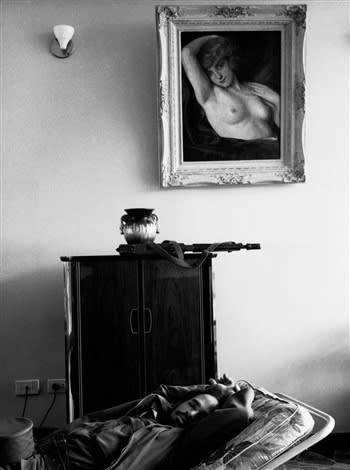
On an art hunt in the late 90s (during Cuba’s Special Period), I met the great Raul Corrales. He was wearing a straw hat, trunks, and flip flops and seemed as grumpy about the heat as he did visitors. In time, he warmed up to me and allowed the, in his words, “the only blonde on the island” to sift though his treasures. I spent a long, hot afternoon with the Great, and remember our conversations and his photographic treasures well.
Raul Corrales was Castro's official photographer from 1959 to 1961. While Korda tended to glorify the revolution and its leaders, Corrales's work was more subtle, reflecting the hardship of a small nation trying to find a new way. One example was a picture showing two pairs of legs outside a café, one wearing ragged trousers and barefoot, the other sporting crisp blue jeans, a leather machete sheath and fine laced boots - a telling reminder of inequality before the revolution.
Caballería (or Cavalry), shows a ragged band of straw-hatted revolutionaries riding on to a plantation of the US-owned United Fruit Company plantation in 1959. The shot was actually taken months after the revolution, and showed Castro supporters re-enacting an 1895 battle in the Cuban war of independence. But Corrales and Castro were well aware of its propaganda significance.
In terms of pure art, Corrales's photograph El Sueño (The Dream, 1959) is generally considered a classic. It shows an exhausted guerrilla asleep on a military cot beneath a framed portrait of a voluptuous woman wearing only a pearl necklace. With one arm resting behind his head, the man echoes the woman's pose, while his rifle, and his cap resting on his groin, add a subtle eroticism suggested by the photograph's title.
Since Corrales was considered something of a national treasure in Cuba, biographies usually locate his birthplace in the province of Ciego de Avila, though some reports suggest he was born in Galicia, Spain, and brought to Cuba as an infant, when his father sought work on the sugar plantations. He himself began as an assistant in a photographic laboratory in 1944, and started taking pictures in the 1950s for the communist newspaper Noticias de Hoy and such magazines as Bohemia and Carteles.
Among his early subjects was Ernest Hemingway, who lived on-and-off between Key West, Florida, and the village of Cojímar, outside Havana, where he got the inspiration to write The Old Man and the Sea. The "old man" of the story was Anselmo Hernández, a fisherman and neighbour of Corrales, and the three men, along with Hemingway's yacht captain Gregorio Fuentes, became regular drinkers at the El Curro bar, on the Cojímar seafront.
While Korda made no shame in photographing to meet beautiful women, Corrales's pictures of poor peasants before the revolution reflected the popular ideals held by the guerrilla leaders. Commenting on Corrales's portraits of desperate sugar-cane cutters and banana farmers, Korda reportedly once told him: "When there's no longer misery in Cuba, Raúl, you're going to starve to death." To be fair, when asked years later to analyse his generation of Cuban photographers, he observed: "And then there's Raúl Corrales, who's the greatest of us all."
